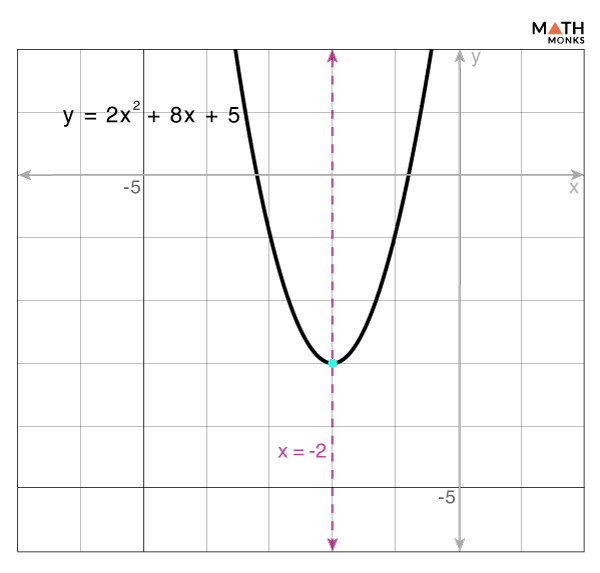The axis of symmetry of a parabola is a vertical line that divides a parabola into two halves. This line passes through the vertex of the parabola, which is the highest or lowest point of the graph, depending on its orientation.
Note: For a parabola facing upward or downward, the axis of symmetry is a vertical line (one is shown above). However, for those that open to the left or right, it is a horizontal line, as shown.
The axis of symmetry is thus the axis of the parabola.
Equations in Standard Form
For quadratic functions in standard form, the axes of symmetry are:
- For y = ax2 + bx + c, the axis of symmetry is: ${x=-\dfrac{b}{2a}}$
- For x = ay2 + by + c, the axis of symmetry is: ${y=-\dfrac{b}{2a}}$
Equations in Vertex Form
When parabolas are in vertex form, the axes of symmetry are:
- For y = a(x – h)2 + k, the axis of symmetry is: x = h
- For x = a(y – k)2 + h, the axis of symmetry is: y = k
Derivation
Considering the standard quadratic function y = ax2 + bx + c
Here, the constant term ‘c’ does not affect the parabola; thus, the equation can be written as y = ax2 + bx …..(i)
According to the definition, the axis of symmetry is the midpoint of its two x-intercepts.
To find the x-intercept, substituting y = 0 in the equation (i), we get
0 = ax2 + bx
⇒ x(ax + b) = 0
⇒ x = 0 and x = ${-\dfrac{b}{2a}}$
Now, the mid-point formula is ${x=\dfrac{\left( x_{1}+x_{2}\right) }{2}}$
⇒ ${x=\dfrac{\left( 0+\left( -\dfrac{b}{a}\right) \right) }{2}}$
⇒ ${x=-\dfrac{b}{2a}}$
This is the equation of the axis of symmetry for parabolas in the standard form y = ax2 + bx + c
Similarly, if the parabola opens horizontally (i.e., left/right), we can get the equation for the axis of symmetry by finding the midpoint of the y-intercepts.
Finding the Axis of Symmetry of the Parabola y = 2x2 + 8x + 5
Given, y = 2x2 + 8x + 5 …..(i)
Comparing the equation (i) of the parabola with the standard form y = ax2 + bx + c, we have
a = 2, b = 8, and c = 5
Using the formula, the axis of symmetry is ${x=-\dfrac{b}{2a}}$
⇒ ${x=-\dfrac{8}{2\times 2}}$
⇒ ${x=-2}$
Thus, the axis of symmetry is x = -2
By plotting the axis of symmetry of the parabola on the graph, we get
Solved Examples
![]() Determine the axis of symmetry of the parabola y = 3x2
Determine the axis of symmetry of the parabola y = 3x2
Solution:
![]()
Given y = 3x2 …..(i)
As we know, the standard form of the parabola is y = ax2 + bx + c …..(ii)
Comparing the equations (i) and (ii), we get
a = 3, b = 0, c = 0
As we know, the axis of symmetry is x = ${-\dfrac{b}{2a}}$
Here, x = ${-\dfrac{0}{2\times 3}}$
⇒ x = ${0}$
Thus, the axis of symmetry is x = 0
![]() Find the axis of symmetry of the parabolic function x = y2 – 4y + 3
Find the axis of symmetry of the parabolic function x = y2 – 4y + 3
Solution:
![]()
Given x = y2 – 4y + 3 …..(i)
As we know, the standard form of the parabola is x = ay2 + by + c …..(ii)
Comparing the equations (i) and (ii), we get
a = 1, b = -4, and c = 3
As we know, the axis of symmetry is y = ${-\dfrac{b}{2a}}$
Here, y = ${-\dfrac{-4}{2\times 1}}$
⇒ y = ${\dfrac{4}{2}}$
⇒ y = ${2}$
Thus, the axis of symmetry is y = 2
![]() Find the equation of the axis of symmetry for f(x) = -x2 + 4x – 1
Find the equation of the axis of symmetry for f(x) = -x2 + 4x – 1
Solution:
![]()
Given f(x) = -x2 + 4x – 1 …..(i)
As we know, the standard form of the parabola is x = ay2 + by + c …..(ii)
Comparing the equations (i) and (ii), we get
a = -1, b = 4, c = -1
As we know, the axis of symmetry is x = ${-\dfrac{b}{2a}}$
Here, x = ${-\dfrac{4}{2\times \left( -1\right) }}$
⇒ x = ${2}$
Thus, the axis of symmetry is x = 2
![]() Find the equation of the axis of symmetry for y = 3(x – 5)2 – 4
Find the equation of the axis of symmetry for y = 3(x – 5)2 – 4
Solution:
![]()
Given y = 3(x – 5)2 – 4 …..(i)
As we know, the vertex form of the parabola is y = a(x – h)2 + k …..(ii)
Comparing the equations (i) and (ii), we get
h = 5 and k = -4
Thus, the axis of symmetry is x = 5
![]() Determine the axis of symmetry of the parabola y = 2(x + 4)2 – 3
Determine the axis of symmetry of the parabola y = 2(x + 4)2 – 3
Solution:
![]()
Given y = 2(x + 4)2 – 3 …..(i)
As we know, the vertex form of the equation of the parabola is y = a(x – h)2 + k …..(ii)
Comparing the equations (i) and (ii), we get
h = 4 and k = -3
Thus, the axis of symmetry is x = 4
![]() Determine the axis of symmetry of the parabola x = 4(y + 3)2 + 1
Determine the axis of symmetry of the parabola x = 4(y + 3)2 + 1
Solution:
![]()
Given x = 4(y + 3)2 + 1 …..(i)
As we know, the vertex form of the parabola is x = a(y – k)2 + h …..(ii)
Comparing the equations (i) and (ii), we get
h = 1 and k = -3
Thus, the axis of symmetry is y = -3


